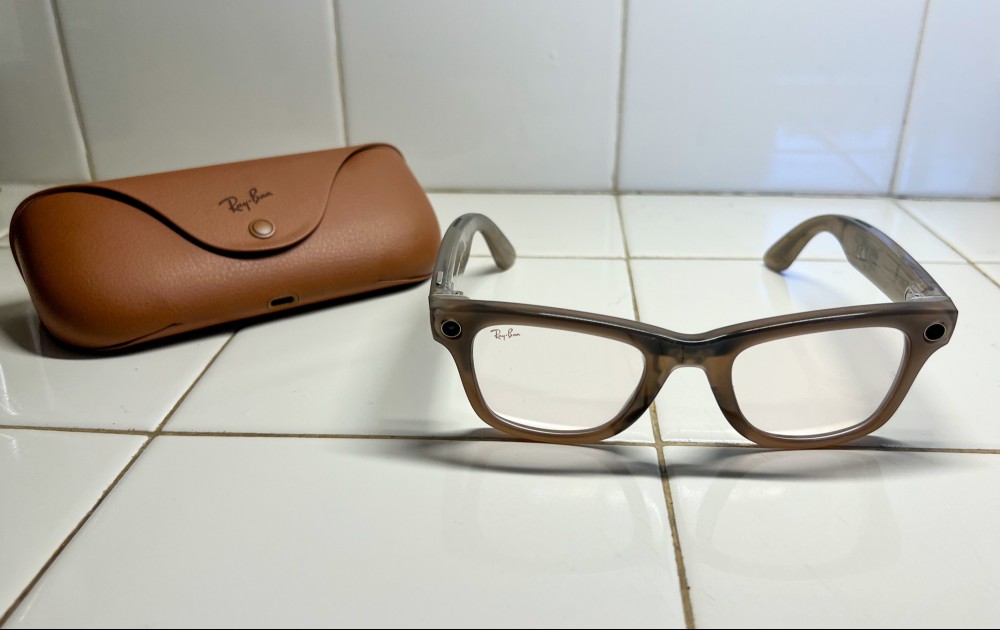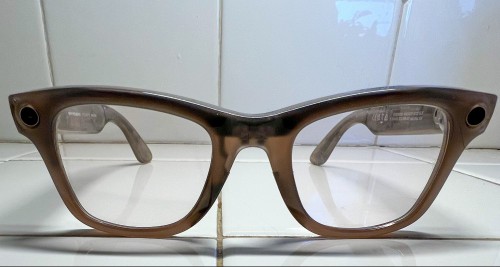My first impression of Ray-Ban Meta smart glasses was that they are living-in-the-future cool; glasses you can talk to feels like something straight out of a syndicated action-adventure TV show from the 1980s. But with daily use, that "new and shiny" vibe wears off quickly.
I've worn Ray-Ban Metas nearly every day since this review was initially posted on November 6, 2024, and my perspective on them has evolved. The novelty may have faded, but these eyeglasses have quietly become essential in my life. Despite a few problems that reveal themselves over time, they are kind of product you don't think about much, but use all the time.
What even are Ray-Ban Meta Glasses?
For the three people who haven’t seen Meta’s ubiquitous advertising campaign: Ray-Ban Meta Glasses are sunglasses/eyeglasses with a built-in camera, speakers, and AI that can be controlled with your voice and simple gestures. They do not have a display screen, though, so you’ll need to look elsewhere if that’s your bag. Meta is working on true AR smart glasses with a built-in display (Orion), but that's likely far off.
Design: Wayfarers are perpetually cool

The design of the Ray-Ban Meta glasses may prove to be the “killer feature” that elevates them above the competition. With glasses, looks are important—you’re wearing them on your face, after all—and unlike the infamous Google Glasses of years ago or other brands of smart glasses on the market, Ray-Ban Meta Glasses are stylish enough that I’d wear them if they didn’t have built-in technology. They come in three time-tested Ray-Ban frame shapes—Skyler, Wayfarer, and Headliner—and offer multiple colors and lens combinations, including the option of prescription lenses. Ray-Ban Metas weigh 49 grams (10 more than my regular specs) and the built-in camera is unobtrusive, so you can wear them all day and not look like a dork (until you say “Hey Meta, what’s the score of the Eagles game?” to yourself on a crowded bus).
Adding prescription lenses bumps the weight up to 54 grams. It doesn't sound like much, but it's noticeable if you wear them all day. In practice, I find myself choosing between Metas and my lighter glasses based on whether I'm planning to take any pictures or text while driving.
Build quality and durability: no complaints
I have to commend Ray-Ban, Meta, and whatever factory physically built these glasses, because they have held up perfectly after nearly a year of regular wear: no warping, bent arms, or other malfunctions. The tech works just as well as it did one day one too, and I have no major glitches or bugs to report.
Technology: Say hello to your little AI friend
There has been a lot of talk in techie circles lately about the possibilities of wearable AI assistants like Humane’s AI Pin or the Rabbit R1, but early reviews have not been positive about either. The idea of replacing your phone with a phone-sized gadget (but only for some tasks, so you still need to carry your phone) just isn’t appealing to most. But cramming AI into your eyeglasses means there’s no extra gadget to take up pocket space, and, because it’s voice activated, it can be operated hands-free.
The set-up and pairing with the companion app, Meta View, was uneventful. A lot of thought seems to have gone into making the user experience as easy as possible. After a brief tutorial, you’re on your own, but if you forget the gesture controls or something, you can ask your glasses to explain them to you again. After nearly a year of use, I've never had to look up anything about how these glasses work.
What Ray-Ban Meta’s AI can do
In basic terms, Ray-Ban Meta’s AI assistant can see what you’re seeing, translate text, and answer questions. If you’re looking at a cool flower, you can say, “Hey, Meta, what kind of flower is that?” Or you can ask, “Hey, Meta, what am I looking at?” And it will describe your view with scary accuracy.
Meta’s AI can tell you what the breakfast hours are of the McDonald’s you’re looking at, tell you whether it gets good reviews, and give you a suggestion for what to order. (Meta recommends the Egg McMuffin.) You can ask it general questions too, like “When does the new season of Severance premiere?” or “What’s the address of Circus Liquor in North Hollywood?” It can even tell jokes—not funny jokes necessarily, but things that are technically jokes.
You can use it to remember things, too. Tell it “remember that I have a doctor’s appointment on the July 12” or “remember that my car is parked in the orange section in space 435,” then later have it recall the information.
All that is definitely cool, but over time, I found I used Meta's AI less and less. It isn't worse than other AI models; I just don't find AI itself too useful in my day-to-day. Maybe your life is different and an AI pal is indispensable, but it's not for me. I do use the translation feature occasionally, and it works well.
Translation: Become instantly multilingual
Since the original review, Meta rolled out the ability to translate from Spanish, French, and Italian to English, and vice-versa, and it's really good. Glasses that translate spoken words with a reasonable amount of accuracy at a real-time, conversational pace is the kind of functional, hassle-free life-improvement that science fiction promises but life rarely delivers on. Language translation might prove to be smart glasses' killer app.
What Ray-Ban Meta’s AI can’t do
As cool as it would be to say, “Hey, Meta, book me a room at the MGM Grand Hotel for this Saturday,” it’s not there yet. Complex tasks that would involve potentially using other apps on your phone aren’t possible. It also can’t give you turn-based directions, identify the song you’re listening to, or remember the name of the person you’re looking at. Also: It only responds to “hey Meta,” not “Hey SPEX” as I’d prefer.
Pictures and video

For influencers and other perpetually online folks, the Ray-Ban Meta’s main selling point is likely its ability to capture images and video, then instantly upload them to Instagram or Facebook with a word. You can also livestream, but only to Instagram and Facebook. A click of the button on the glasses arm, or saying “Hey, Meta, take a picture,” will take a snapshot of what you’re looking at, so you can capture a still or a video while you're riding a bike or driving.
The resolution of the Ray-Ban’s photos doesn’t equal a modern smartphone, but a 12 MP camera that takes 3024x4032 still images and 1080p video isn’t potato-quality, either. It does a fairly nice job with lower light situations, too. Speaking of the video: I was impressed with the Meta-Ray Ban’s image stabilization and the wide field of view, but bummed that it only shoots in one, vertical aspect ratio: perfect for TikTok but bad for a feature film. Check it out yourself:
Because there’s no viewfinder, it’s difficult to frame shots, so it’s best used for casual, on-the-fly images instead of careful compositions, and you’ll probably need to crop everything later for best results. Here's a straight-from-the-glasses photo, taken in a lower-light hallway, to give you an idea of the image quality:

In contrast to the AI features, I found myself using the photo and video capture more than I thought I would—it became my favorite thing about these glasses. It's weird to think of a smartphone as being inconvenient, but once you can say “Hey Meta, take a picture” or just hit a button on your glasses, you realize how much easier it is. Before I had these glasses I wouldn't have been able to photograph the license plate of the reckless driver on the freeway, the interesting bug on my tomato plant, or the impressive things I see while riding a bike, but now I can. Check it out:
Ray-Ban Meta glasses as a communication tool
You can use Ray-Bans to send texts, make and answer voice calls, and make video calls. Being able to hear and send text while riding a bicycle or driving a car is very handy.
You can switch between your glasses-camera and your phone's camera in a video call on WhatsApp and Messenger, so if you need to show someone something, your pal can see the world through your eyes. (It won't work on FaceTime or other non-Meta platforms.) Kind of creepy, but kind of cool. This all worked exactly as expected, with little hassle—all I really want out of tech gadgets.
Texting and calling is another Meta feature I use daily.
Using your Ray-Ban Meta glasses to play music
Along with taking snapshots and telling jokes, the Ray-Ban Meta glasses pair directly with Spotify, Apple Music, Amazon Music, and Calm through a connected device, and can be used as a Bluetooth speaker to play whatever you like. With a command of “play music” you can start the tunes, and then skip ahead with a tap on the glasses or a “skip song” command. The volume can be controlled the same way.
Like the video quality, the audio is fine, but not near the level of a decent set of headphones or earbuds. The highs and mids are clear; the bass is weak, overall, it’s merely adequate, podcast-while-cooking level audio, not "I'm really getting into The Beach Boys' Love You album" audio.
Battery life
The glasses boast a battery life of “up to four hours,” but this varies based on usage. That's short, especially if this is your everyday wear. The Ray-Ban Meta case contains additional battery power, allowing for eight more charges on the go. If you were using them as sunglasses, this would likely be enough power, but for prescription-wearers, it's lacking, and the real-life result is having to pack a second pair of glasses for longer excursions. Meta says its Oakley-branded smart glasses will have an eight-hour charge, which would be ideal, but for the Ray-Bans, a longer battery life would be a definite plus.
Any discussion of what something is worth is subjective, but $299 for the base Wayfarer model is less than I paid for my last set of frames, and they don’t answer me when I talk to them. For comparison, the cost of the cheapest Humane AI pin is $499 and requires a monthly subscription, while the Rabbit R1 runs $199.
With their retro design, practical AI capabilities, and hands-free operation, Ray-Ban Metas are the kind of glasses Q would have given to James Bond. While there are limitations, like the weight and battery life, overall, Ray-Ban Meta glasses are an “I didn’t know I always needed this” gadget that makes many things I do anyway, like taking pictures and sending texts, easier and cooler.
Covering smart glasses, VR headsets, popular culture, and more.
